Prince of Wales
Prince of Wales (Welsh: Tywysog Cymru, pronounced [təu̯ˈəsoɡ ˈkəmrɨ]; Latin: Princeps Cambriae/Walliae) is a title traditionally given to the male heir apparent to the English and, later, British thrones. The title originated with the Welsh rulers of Gwynedd who, from the late 12th century, used it (albeit inconsistently) to assert their supremacy over the other Welsh rulers. However, to mark the finalisation of his conquest of Wales, in 1301, Edward I of England, invested his son Edward of Caernarfon with the title, thereby beginning the tradition of giving the title to the heir apparent when he was the monarch's son or grandson. The title was later claimed by the leader of a Welsh rebellion, Owain Glyndŵr, from 1400 until 1415.
| Prince of Wales | |
|---|---|
| Tywysog Cymru | |
 | |
| Style | His Royal Highness |
| Member of | British royal family |
| Appointer | Monarch of the United Kingdom (previously of England) |
| Term length | Life tenure or until accession as sovereign |
| Formation |
|
| First holder |
|
The current holder of the title is William, who was designated Prince of Wales by his father, King Charles III, on 9 September 2022, with formal letters patent issued on 13 February 2023. The title has, in recent years, become a point of controversy in Wales.
Welsh princes of Wales
Origins to 1283
The first known Welsh ruler to refer to himself as the Prince of Wales was Owain Gwynedd, in about 1165 in the third of his letters to Louis VII of France. It is likely that this was to assert his pre-eminence over the other Welsh princes.[1][2]: 86 [3]
The next to assume the title was the grandson of Owain Gwynedd, Llywelyn ap Iorwerth (Llywelyn the Great).[4] In 1215, the Welsh and Scots had joined English rebel barons in forcing King John to sign Magna Carta, which included return of lands to the Welsh and the return of Llywelyn's hostage son, Gruffydd.[5] Llywelyn went on to gain dominance over all Wales the following year and in 1218 Henry III formally recognised Llywelyn as Prince of Wales in the Treaty of Worcester.[6]
Although Llywelyn's son, Dafydd was forced to give up his father's claims, his nephew, Llywelyn ap Gruffydd (also known as Llywelyn II[7] or Llywelyn the Last), controlled almost all of "Welsh Wales" (Pura Wallia) and began using the Prince of Wales title with Scottish backing.[8] In 1258 much of Wales appeared united behind Llywelyn and against the English. Taking advantage of cvil war in England, Henry III agreed the Treaty of Montgomery in 1267, recognising Llywelyn as Prince of Wales.[9]
In 1277, the invasion of Edward I of England into Wales forced Llywelyn II into the Treaty of Aberconwy, meaning he would lose much of the ground previously gained, but would keep the Prince of Wales title.[10] The invasion was over a series of disputes[11]: 409 but Edward was not intent on conquest at that stage, and negotiated the settlement when Llywelyn surrendered.[12]: 151 War broke out again in 1282, as a result of a rebellion by Llywelyn's brother Dafydd, who was discontented with the reward he had received from Edward in 1277. Edward I was drawn into war again and this time he turned it into a war of conquest.[13]: 348 The war turned in Edward's favour when Llywelyn unexpectedly marched out of North Wales towards Builth in mid-Wales.[12]: 155 He was lured into a trap and killed at the Battle of Orewin Bridge on 11 December 1282.[13]: 353 [12]: 155 Dafydd briefly assumed the title of Prince of Wales before he too was captured and executed in 1283.[14]
In 1284, Edward introduced the royal ordinance of the Statute of Rhuddlan, formally ending the independent Welsh Principality of Wales and annexing its territory to the crown of England.[15]: 23–24 [16]
Owain Glyndŵr
After over a century of English rule, supporters of Welsh leader Owain Glyndŵr (c. 1354 – c. 1415) proclaimed him Prince of Wales on 16 September 1400 in Glyndyfrdwy, at the start of the Welsh Revolt.[17] The revolt briefly brought back the prospect of Welsh independence but it faltered in 1407, and by 1409 Wales was subdued. Glyndŵr eventually retreated to the Welsh wilderness with a band of loyal supporters, where he refused to surrender and continued the war with guerrilla tactics. The last documented sighting of him was in 1412 and he may have died in 1415.[18]
Heirs apparent to the English or British thrones
First English Prince of Wales

In order to finalise his conquest of Wales, Edward I began the custom of granting the title of Prince of Wales to the heir apparent to the English throne.[19] Consequently, in 1301, Edward invested his Welsh-born eldest son, Edward of Caernarfon, as the first Plantagenet Prince of Wales.[20]
Writing in Britannia, William Camden describes the killing of Llywelyn and Edward's use of the title "Prince of Wales" for his son:[21]
As concerning the Princes of Wales of British bloud in ancient times, you may reade in the Historie of Wales published in print. For my part I thinke it requisite and pertinent to my intended purpose to set downe summarily those of latter daies, descended from the roiall line of England. King Edward the First, unto whom his father King Henrie the Third had granted the Principalitie of Wales, when hee had obtained the Crowne and Lhewellin Ap Gryffith, the last Prince of the British race, was slain, and therby the sinewes as it were of the principalitie were cut, in the twelft yeere of his reigne united the same unto the Kingdome of England. And the whole province sware fealty and alleageance unto Edward of Caernarvon his sonne, whom hee made Prince of Wales. But King Edward the Second conferred not upon his sonne Edward the title of Prince of Wales, but onely the name of Earle of Chester and of Flint, so farre as ever I could learne out of the Records, and by that title summoned him to Parliament, being then nine yeres old. King Edward the Third first created his eldest sonne Edward surnamed the Blacke Prince, the Mirour of Chivalrie (being then Duke of Cornwall and Earle of Chester), Prince of Wales by solemne investure, with a cap of estate and Coronet set on his head, a gold ring put upon his finger, and a silver vierge delivered into his hand, with the assent of Parliament.[22]
— William Camden, Britannia (1607)
Titles and roles
.png.webp)
The title is neither automatic nor heritable; it merges with the Crown when its holder eventually accedes to the throne, or reverts to the Crown if its holder predeceases the current monarch, leaving the sovereign free to grant it to the new heir apparent (such as the late prince's son or brother).[23]
In 2011, along with the other Commonwealth realms, the United Kingdom committed to the Perth Agreement, which proposed changes to the laws governing succession, including altering the male-preference primogeniture to absolute primogeniture.[24] The Succession to the Crown Act 2013 was introduced to the British parliament on 12 December 2012, published the next day, and received royal assent on 25 April 2013.[25] It was brought into force on 26 March 2015,[26] at the same time as the other realms implemented the Perth Agreement in their own laws.[27]
Since 1301, the title 'Earl of Chester' has generally been granted to each heir apparent to the English throne, and from the late 14th century it has been given only in conjunction with that of 'Prince of Wales'. Both titles are bestowed to each individual by the sovereign and are not automatically acquired.[28]
The Prince of Wales usually has other titles and honours, if the eldest son of the monarch; typically this means being Duke of Cornwall, which, unlike being Prince of Wales, inherently includes lands and constitutional and operational responsibilities. The duchy of Cornwall was created in 1337 by Edward III for his son and heir, Edward of Woodstock (also known as 'The Black Prince'). A charter was also created which ruled that the eldest son of the king would be the Duke of Cornwall.[29]
No formal public role or responsibility has been legislated by Parliament or otherwise delegated to the prince of Wales by law or custom. In that role, Charles often assisted Elizabeth II in the performance of her duties. He represented her when welcoming dignitaries to London and during state visits. He also represented the Queen and the United Kingdom overseas at state and ceremonial occasions such as funerals.[30] The Prince of Wales has also been granted the authority to issue royal warrants.[31]
Insignia
.svg.png.webp)
The Prince of Wales's feathers are the badge of the Prince of Wales by virtue of being the heir apparent.[32] The ostrich feathers are generally traced back to Edward of Woodstock ('The Black Prince'). He bore (as an alternative to his differenced royal arms) a shield of Sable, three ostrich feathers argent, described as his "shield for peace", probably meaning the shield he used for jousting. These arms appear several times on his chest tomb in Canterbury Cathedral, alternating with his paternal royal arms (the royal arms of King Edward III differenced by a label of three points argent).[33] The Black Prince also used heraldic badges of one or more ostrich feathers in various other contexts.[34]
1969 investiture of Prince Charles
Although the investiture of Charles as Prince of Wales in 1969 took place during a period of social change and a growing Welsh nationalist movement, it was largely welcomed by people in Wales.[35] The investiture was also attended, by invitation, by 3,500 people who lived and worked in Wales.[36] In the UK, the press focused on the pomp and regalia, with newspaper headlines such as "Welsh go wild for Their Royal Prince" and "Proud Wales takes Prince to her heart."[37] It was also supported by the Secretary of State for Wales at the time, George Thomas, although he remained a controversial figure in Wales.[38] Thomas later said to Prime Minister Harold Wilson that Charles's speech had "boosted Welsh nationalism."[37]
The 1960s movement surrounding the investiture has historically been described as the "anti-investiture movement"[39]: 207 [40][41] and "anti-investiture sentiment".[42] The investiture occurred during a period of revival of the Welsh national consciousness, with an outspoken section considering him as an English Prince being imposed upon Wales.[43] The investiture also led to significant protests in Wales. The group "Cofia 1282" ("Remember 1282") also held protests against the investiture.[44]
William as Prince of Wales
On 9 September 2022 (the day after his accession to the throne), during his first address as king, Charles III said of his son William, "Today I am proud to create him Prince of Wales, Tywysog Cymru. The country whose title I've been so greatly privileged to bear during so much of my life of duty."[45] Buckingham Palace stated that "The Prince and Princess [of Wales] look forward to celebrating Wales's proud history and traditions as well as a future that is full of promise".[46] The First Minister of Wales, Mark Drakeford, noted that "William will be absolutely aware of the sensitivities that surround the title..."[45] Though the title started to be used immediately afterward, it was only officially bestowed by letters patent on 13 February 2023.[47][48]
Contemporary debate
Title
Charles III proclaimed William as Prince of Wales on 9 September 2022, the day after the death of Elizabeth II, surprising Mark Drakeford, First Minister of Wales, who said he had not been given notice of the announcement. The creation of a new Prince of Wales was the catalyst for a renewed debate on the title, and already, on 8 September, a petition had been started calling for the title to be ended. The petition had garnered 25,000 signatures in its first few days.[49]
Former Welsh Assembly presiding officer, Lord Elis-Thomas, had also questioned the need for the title to continue, and recalled previous discussion with the then Prince Charles, who expressed his desire never again to have an investiture in Caernarfon Castle. According to Elis-Thomas, Charles laughed and said, "Do you think I want to put William through what I went through?".[50]
The question raised by critics was one of respect for Wales as a country in its own right, and the continued symbol of the historical invasion and oppression of Wales. William pledged that he would serve Wales with humility and great respect for its people, and spoke of the honour he felt to do so. He signalled a desire to reform the role.[51]
The contemporary debate does not focus wholly on abolition, but explores how, if the title is to continue, it may be adapted to reflect the realities of the changing constitutional relationship with Wales. This includes the question of whether the Welsh Government should play a greater role in the appointments process, or whether there should be a Senedd ceremonial process to reflect the nation’s governance over its own affairs.[49]
Opinion polls
A BBC Wales poll in 1999 showed that 73% of Welsh speakers believed the title should continue after Charles.[52] A BBC poll in 2009, 40 years following the investiture, revealed 58% of Welsh people support the title "Prince of Wales"; 26% opposed the title. However, only 16% responded that Wales had benefited from having a prince.[53][54]
In July 2018, an ITV poll found that 57% of Welsh people supported the title passing to William, with 22% for abolition or vacating the title. Support for another investiture was lower, with 31% supporting a ceremony similar to the 1969 one, 18% supporting a ceremony different to 1969, and 27% opposing an investiture.[55]
In 2019, a BBC Wales poll showed that 50% supported the continuation of the title and 22% opposed. On the investiture, 41% supported a similar ceremony to 1969, 20% a different-style investiture ceremony, and 30% opposed any future investiture.[56][57] A 2021 poll by Beaufort Research for Western Mail showed 61% of respondents in Wales supported another investiture, including 60% of Welsh-speakers polled.[58]
In June 2022, an ITV/YouGov poll showed that 46% of adults in Wales wanted the Prince of Wales title to continue, and 31% said it should be abolished.[59] In September 2022, a YouGov poll showed 66% support for Prince William to be given the title compared to 22% opposed, with 19% supporting a 1969-style investiture, 30% a different style of investiture and 34% opposing any investiture of Prince William as Prince of Wales.[60]
List of princes of Wales (English or British heirs apparent)
| Person | Name | Heir of | Birth | Became heir apparent | Created Prince of Wales | Ceased to be Prince of Wales | Death |
|---|---|---|---|---|---|---|---|
 | Edward of Caernarfon | Edward I | 25 April 1284 | 19 August 1284 | 7 February 1301[28] | 7 July 1307 acceded to throne as Edward II | 21 September 1327 |
| Edward of Woodstock | Edward III | 15 June 1330 | 12 May 1343[28] | 8 June 1376 deceased | |||
 | Richard of Bordeaux | 6 January 1367 | 8 June 1376 | 20 November 1376[28] | 22 June 1377 acceded to throne as Richard II | 14 February 1400 | |
 | Henry of Monmouth | Henry IV | 16 September 1386 | 30 September 1399 | 15 October 1399[28] | 21 March 1413 acceded to throne as Henry V | 31 August 1422 |
 | Edward of Westminster | Henry VI | 13 October 1453 | 15 March 1454[28] | 11 April 1471 father deposed | 4 May 1471 deceased | |
 | Edward of York | Edward IV | 4 November 1470 | 11 April 1471 | 26 June 1471[28] | 9 April 1483 acceded to throne as Edward V | 1483 |
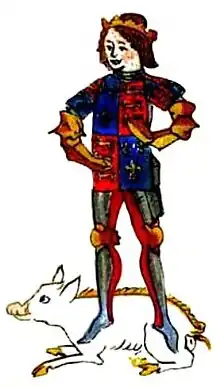 | Edward of Middleham | Richard III | 1473 | 26 June 1483 | 24 August 1483[28] | 31 March or 9 April 1484 deceased | |
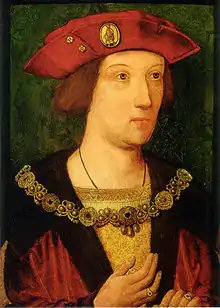 | Arthur Tudor | Henry VII | 20 September 1486 | 29 November 1489[28] | 2 April 1502 deceased | ||
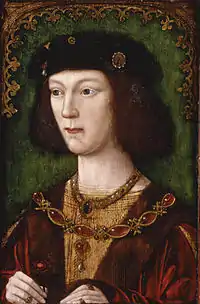 | Henry Tudor | 28 June 1491 | 2 April 1502 | 18 February 1504[28] | 21 April 1509 acceded to throne as Henry VIII | 28 January 1547 | |
 | Edward Tudor | Henry VIII | 12 October 1537 | c. 18 October 1537[61][62] | 28 January 1547 acceded to throne as Edward VI | 6 July 1553 | |
 | Henry Frederick Stuart | James I | 19 February 1594 | 24 March 1603 | 4 June 1610[28] | 6 November 1612 deceased | |
.jpg.webp) | Charles Stuart | 19 November 1600 | 6 November 1612 | 4 November 1616[28] | 27 March 1625 acceded to throne as Charles I | 30 January 1649 | |
 | Charles Stuart | Charles I | 29 May 1630 | c. 1638–1641[28] | 30 January 1649 title abolished; later (1660) acceded to throne as Charles II | 6 February 1685 | |
 | James Francis Edward Stuart | James II | 10 June 1688 | c. 4 July 1688[28] | 11 December 1688[63] father deposed | 1 January 1766 | |
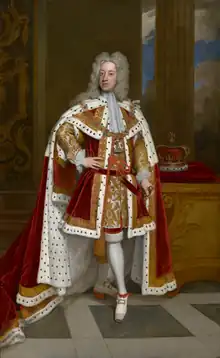 | George Augustus | George I | 10 November 1683 | 1 August 1714 | 27 September 1714[28][64] | 11 June 1727 acceded to throne as George II | 25 October 1760 |
 | Frederick Louis | George II | 1 February 1707 | 11 June 1727 | 7 January 1728[28][65] | 31 March 1751 deceased | |
 | George William Frederick | 4 June 1738 | 31 March 1751 | 20 April 1751[28][66] | 25 October 1760 acceded to throne as George III | 29 January 1820 | |
 | George Augustus Frederick | George III | 12 August 1762 | 17 August 1762[28][67] | 29 January 1820 acceded to throne as George IV | 26 June 1830 | |
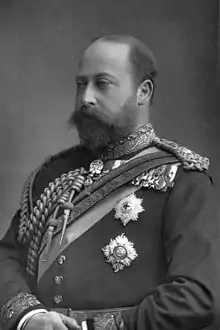 | Albert Edward | Victoria | 9 November 1841 | 8 December 1841[28][68] | 22 January 1901 acceded to throne as Edward VII | 6 May 1910 | |
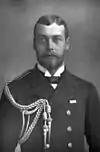 | George Frederick Ernest Albert | Edward VII | 3 June 1865 | 22 January 1901 | 9 November 1901[28][69] | 6 May 1910 acceded to throne as George V | 20 January 1936 |
.jpg.webp) | Edward Albert Christian George Andrew Patrick David | George V | 23 June 1894 | 6 May 1910 | 23 June 1910[28][70] Investiture: 13 July 1911 | 20 January 1936 acceded to throne as Edward VIII; later (1937) Duke of Windsor | 28 May 1972 |
 | Charles Philip Arthur George | Elizabeth II | 14 November 1948 | 6 February 1952 | 26 July 1958[28][71] Investiture: 1 July 1969 | 8 September 2022 acceded to throne as Charles III | living |
 | William Arthur Philip Louis | Charles III | 21 June 1982 | 8 September 2022 | 9 September 2022[47][72] | Incumbent | living |
The current sovereign Charles III was the longest serving Prince of Wales for 64 years and 44 days between 1958 and 2022, and the oldest person to hold the position. He was also heir apparent for longer than any other in British history.[73] Upon the death of his mother on 8 September 2022, Charles became king and the title merged with the Crown.[74] The following day, King Charles III bestowed the title upon his elder son, Prince William, Duke of Cornwall and Cambridge.[75][47] Prince William is the oldest person to be created Prince of Wales.
Family tree
| Family tree of the Princes of Wales, Dukes of Cornwall, Dukes of Rothesay, Earls of Carrick and Earls of Chester | |||||||||||||||||||||||||||||||||||||||||||||||||||||||||||||||||||||||||||||||||||||||||||||||||||||||||||||||||||||||||||||||||||||||||||||||||||||||||||||||||||||||||||||||||||||||||||||||||||||||||||||||||||||||||||||||||||||||||||||||||||||||||||||||||||||||||||||||||||||||||||||||||||||||||||||||||||||||||||||||||||||||||||||||||||||||||||||||||||||||||||||||||||||||||||||||||||||||||||||||||||||||||||||||||||||||||||||||||||||||||||||||||||||||||||||||||||||||||||||||||||||||||||||||||||||||||||||||||||||||||||||||||||||||||||||||||||||||||||||||||||||||||||||||||||||||||||||||||||||||||||||||||||||||||||||||||||||||||||||||||||||||||||||||||||||||||||||||||||||||||||||||||||||||||||||||||||||||||||||||||||||||||||||||||||||||||||||||||||||||||||||||||||||||||||||||||||||||||||||||||||||||||||||||||||||||||||||||||||||||||||||||||||||||||||||||||||||||||||||||||||||||||||||||||||||||||||||||||||||||||||||||||||||||||||||||||||||||||||||||||||||||||||||||||||||||||||||||||||||||
|---|---|---|---|---|---|---|---|---|---|---|---|---|---|---|---|---|---|---|---|---|---|---|---|---|---|---|---|---|---|---|---|---|---|---|---|---|---|---|---|---|---|---|---|---|---|---|---|---|---|---|---|---|---|---|---|---|---|---|---|---|---|---|---|---|---|---|---|---|---|---|---|---|---|---|---|---|---|---|---|---|---|---|---|---|---|---|---|---|---|---|---|---|---|---|---|---|---|---|---|---|---|---|---|---|---|---|---|---|---|---|---|---|---|---|---|---|---|---|---|---|---|---|---|---|---|---|---|---|---|---|---|---|---|---|---|---|---|---|---|---|---|---|---|---|---|---|---|---|---|---|---|---|---|---|---|---|---|---|---|---|---|---|---|---|---|---|---|---|---|---|---|---|---|---|---|---|---|---|---|---|---|---|---|---|---|---|---|---|---|---|---|---|---|---|---|---|---|---|---|---|---|---|---|---|---|---|---|---|---|---|---|---|---|---|---|---|---|---|---|---|---|---|---|---|---|---|---|---|---|---|---|---|---|---|---|---|---|---|---|---|---|---|---|---|---|---|---|---|---|---|---|---|---|---|---|---|---|---|---|---|---|---|---|---|---|---|---|---|---|---|---|---|---|---|---|---|---|---|---|---|---|---|---|---|---|---|---|---|---|---|---|---|---|---|---|---|---|---|---|---|---|---|---|---|---|---|---|---|---|---|---|---|---|---|---|---|---|---|---|---|---|---|---|---|---|---|---|---|---|---|---|---|---|---|---|---|---|---|---|---|---|---|---|---|---|---|---|---|---|---|---|---|---|---|---|---|---|---|---|---|---|---|---|---|---|---|---|---|---|---|---|---|---|---|---|---|---|---|---|---|---|---|---|---|---|---|---|---|---|---|---|---|---|---|---|---|---|---|---|---|---|---|---|---|---|---|---|---|---|---|---|---|---|---|---|---|---|---|---|---|---|---|---|---|---|---|---|---|---|---|---|---|---|---|---|---|---|---|---|---|---|---|---|---|---|---|---|---|---|---|---|---|---|---|---|---|---|---|---|---|---|---|---|---|---|---|---|---|---|---|---|---|---|---|---|---|---|---|---|---|---|---|---|---|---|---|---|---|---|---|---|---|---|---|---|---|---|---|---|---|---|---|---|---|---|---|---|---|---|---|---|---|---|---|---|---|---|---|---|---|---|---|---|---|---|---|---|---|---|---|---|---|---|---|---|---|---|---|---|---|---|---|---|---|---|---|---|---|---|---|---|---|---|---|---|---|---|---|---|---|---|---|---|---|---|---|---|---|---|---|---|---|---|---|---|---|---|---|---|---|---|---|---|---|---|---|---|---|---|---|---|---|---|---|---|---|---|---|---|---|---|---|---|---|---|---|---|---|---|---|---|---|---|---|---|---|---|---|---|---|---|---|---|---|---|---|---|---|---|---|---|---|---|---|---|---|---|---|---|---|---|---|---|---|---|---|---|---|---|---|---|---|---|---|---|---|---|---|---|---|---|---|---|---|---|---|---|---|---|---|---|---|---|---|---|---|---|---|---|---|---|---|---|---|---|---|---|---|---|---|---|---|---|---|---|---|---|---|---|---|---|---|---|---|---|---|---|---|---|---|---|---|---|---|---|---|---|---|---|---|---|---|---|---|---|---|---|---|---|---|---|---|---|---|---|---|---|---|---|---|---|---|---|---|---|---|---|---|---|---|---|---|---|---|---|---|---|---|---|---|---|---|---|---|---|---|---|---|---|---|---|---|---|---|---|---|---|---|---|---|---|---|---|---|---|---|---|---|---|---|---|---|---|---|---|---|---|---|---|---|---|---|---|---|---|---|---|---|---|---|---|---|---|---|---|---|---|---|---|---|---|---|---|---|---|---|---|---|---|---|---|---|---|---|---|---|---|---|---|---|---|---|---|---|---|---|---|---|---|---|---|---|---|---|---|---|---|---|---|---|---|---|---|---|---|---|---|---|---|---|---|---|---|---|---|---|---|---|---|---|---|---|---|---|---|---|---|---|---|---|---|---|---|---|---|---|---|---|---|---|---|---|---|---|---|---|---|---|---|---|---|---|---|---|---|---|---|---|---|---|---|---|---|---|---|---|---|---|---|---|---|---|---|---|---|---|---|---|---|---|---|---|---|---|---|---|---|---|---|---|---|---|---|---|---|---|---|---|---|---|---|---|---|---|---|---|---|---|---|---|---|---|---|---|---|---|---|---|---|---|---|---|---|---|---|---|---|---|---|---|---|---|---|---|---|---|---|---|---|
| |||||||||||||||||||||||||||||||||||||||||||||||||||||||||||||||||||||||||||||||||||||||||||||||||||||||||||||||||||||||||||||||||||||||||||||||||||||||||||||||||||||||||||||||||||||||||||||||||||||||||||||||||||||||||||||||||||||||||||||||||||||||||||||||||||||||||||||||||||||||||||||||||||||||||||||||||||||||||||||||||||||||||||||||||||||||||||||||||||||||||||||||||||||||||||||||||||||||||||||||||||||||||||||||||||||||||||||||||||||||||||||||||||||||||||||||||||||||||||||||||||||||||||||||||||||||||||||||||||||||||||||||||||||||||||||||||||||||||||||||||||||||||||||||||||||||||||||||||||||||||||||||||||||||||||||||||||||||||||||||||||||||||||||||||||||||||||||||||||||||||||||||||||||||||||||||||||||||||||||||||||||||||||||||||||||||||||||||||||||||||||||||||||||||||||||||||||||||||||||||||||||||||||||||||||||||||||||||||||||||||||||||||||||||||||||||||||||||||||||||||||||||||||||||||||||||||||||||||||||||||||||||||||||||||||||||||||||||||||||||||||||||||||||||||||||||||||||||||||||||
See also
References
- Huw, Pryce (1998). "Owain Gwynedd And Louis VII: The Franco-Welsh Diplomacy of the First Prince of Wales". Welsh History Review. 19 (1): 1–28.
- Turvey, Roger (2013). Owain Gwynedd: Prince of the Welsh. Y Lolfa. pp. 84–86. ISBN 978-1-84771-694-1.
- Pierce, Thomas Jones (1959). "Owain Gwynedd (c.1100 - 1070), King of Gwynedd". Dictionary of Welsh Biography. National Library of Wales.
- Pierce, Thomas Jones (1959). "LLYWELYN ap IORWERTH". Dictionary of Welsh Biography. National Library of Wales.
- Carpenter, David (2015). "Magna Carta: Wales, Scotland and Ireland". Hansard.
- Pierce, Thomas Jones (1959). "Llywelyn ap Iorwerth ('Llywelyn the Great', often styled 'Llywelyn I', prince of Gwynedd)". Dictionary of Welsh Biography. National Library of Wales.
- "LLYWELYN ap GRUFFYDD ('Llywelyn the Last,' or Llywelyn II), Prince of Wales (died 1282)". Dictionary of Welsh Biography. National Library of Wales.
- Moore, David (10 January 2007). The Welsh Wars of Independence. The History Press. ISBN 978-0-7524-9648-1. Retrieved 22 March 2023.
- Gower, Jon (2013). The Story of Wales. BBC Books. pp. 109–120. ISBN 978-1-84990-373-8.
- Gower, Jon (2013). The Story of Wales. BBC Books. pp. 109–120. ISBN 978-1-84990-373-8.
- Powicke, F. M. (1962). The Thirteenth Century: 1216–1307 (2nd ed.). Oxford: Clarendon Press. ISBN 978-0-19-82-1708-4.
- Prestwich, Michael (2007). Plantagenet England: 1225–1360 (new ed.). Oxford: Oxford University Press. ISBN 978-0-19-822844-8.
- Davies, R. R. (2000). The Age of Conquest: Wales, 1063–1415. St. Martin's Press. ISBN 0-19-820198-2.
- Pierce, Thomas Jones (1959). "Dafydd ap Gruffydd (David III, died 1283), prince of Gwynedd". Dictionary of Welsh Biography. National Library of Wales.
- Pilkington, Colin (2002). Devolution in Britain today. Manchester University Press. pp. 23–24. ISBN 978-0-7190-6075-5.
- Walker, David (28 June 1990). Medieval Wales. Cambridge University Press. p. 139. ISBN 978-0-521-31153-3. Archived from the original on 11 January 2023. Retrieved 10 September 2022.
- Gower, John (2012). The Story of Wales. BBC Books. p. 137.
- Davies, R. R. (2009). Owain Glyndwr: Prince of Wales. Y Lolfa. ISBN 978-1-84771-127-4. Archived from the original on 12 January 2023. Retrieved 14 September 2022.
- Corbishley, Mike (1998). The Young Oxford History of Britain & Ireland. Oxford University Press. p. 127. ISBN 978-0-19-910466-6.
- Dawson, Ian; Watson, Paul (1991). Medieval Realms 1066-1500. Oxford University Press. p. 29. ISBN 978-0-19-917190-3.
- Camden, William (1607). Britannia. pp. Glamorganshire. Archived from the original on 5 September 2022. Retrieved 5 September 2022.
- Glamorganshire Archived 31 January 2009 at the Wayback Machine. Philological.bham.ac.uk. Retrieved on 2012-07-15.
- Titles and Heraldry Archived 19 April 2020 at the Wayback Machine - website of the Prince of Wales
- Laura Smith-Spark (28 October 2011). "Girls given equal rights to British throne under law changes". CNN. Archived from the original on 19 June 2017. Retrieved 15 July 2012.
- Succession to the Crown Act. Archived 12 January 2021 at the Wayback Machine Parliament of the United Kingdom.
- Succession to the Crown Act 2013 (Commencement) Order 2015 Archived 29 May 2021 at the Wayback Machine at legislation.org.uk (retrieved 30 March 2015)
- Statement by Nick Clegg MP, UK parliament website Archived 5 July 2016 at the Wayback Machine, 26 March 2015 (retrieved on same date).
- l Previous Princes Archived 14 October 2013 at the Wayback Machine. Prince of Wales official website. Retrieved on 15 July 2013.
- "History of the Duchy | The Duchy of Cornwall". duchyofcornwall.org. Archived from the original on 4 October 2022. Retrieved 5 September 2022.
- "The Prince of Wales - Royal Duties". Clarence House. Archived from the original on 26 July 2015. Retrieved 10 August 2015.
- Emma.Goodey (4 April 2016). "Royal warrants". The Royal Family. Archived from the original on 13 January 2022. Retrieved 5 September 2022.
- Fox-Davies, Arthur Charles (1909). A Complete Guide to Heraldry. London: T.C. & E.C. Jack. LCCN 09023803 – via Internet Archive.
the Prince of Wales is the only one who rejoices in the possession of officially assigned badges. The badge of the eldest son of the Sovereign, as such, and not as Prince of Wales, is the plume of three ostrich feathers, enfiled with the circlet from his coronet. Recently an additional badge (on a mount vert, a dragon passant gules, charged on the shoulder with a label of three points argent) has been assigned to His Royal Highness. This action was taken with the desire to in some way gratify the forcibly expressed wishes of Wales, and it is probable that, the precedent having been set, it will be assigned to all those who may bear the title of Prince of Wales in future.
- Scott Giles 1929, pp. 89–91.
- Siddons 2009, pp. 178–9.
- Archives, The National (24 May 2022). "The National Archives - The Investiture of the Prince of Wales". The National Archives blog. Retrieved 5 October 2022.
- Davies, Christopher (2 October 2022). "Remembering the 1969 Prince of Wales investiture at Caernarfon Castle". North Wales Live. Retrieved 5 October 2022.
- "When a young Charles was crowned Prince of Wales — and spoke in Welsh". Washington Post. ISSN 0190-8286. Retrieved 6 October 2022.
- Shipton, Martin (22 September 2017). "George Thomas was a 'sanctiminous hypocrite' - Shipton". WalesOnline. Retrieved 5 October 2022.
- Ellis, John Stephen (2008). Investiture: Royal Ceremony and National Identity in Wales, 1911-1969. University of Wales Press. ISBN 978-0-7083-2000-6.
- King, Richard (22 February 2022). Brittle with Relics: A History of Wales, 1962–97 ('Oral history at its revelatory best' DAVID KYNASTON). Faber & Faber. ISBN 978-0-571-29566-1.
- Morra, Irene; Gossedge, Rob (30 September 2016). The New Elizabethan Age: Culture, Society and National Identity after World War II. Bloomsbury Publishing. ISBN 978-0-85772-834-0.
- Deacon, Thomas (24 February 2019). "Prince Charles, the investiture and bombs: How nationalists tried to stop it". WalesOnline. Retrieved 11 September 2022.
- "Should there be a Prince of Wales investiture in 21st century Wales?". ITV News. 14 September 2022. Retrieved 14 September 2022.
- "50 years since the Investiture". National Library of Wales Blog. 1 July 2019. Retrieved 8 September 2022.
- "Drakeford: 'There's no rush' for an investiture for new Prince of Wales". ITV News. 12 September 2022. Retrieved 24 September 2022.
- "Prince of Wales: William speaks of honour after getting title". BBC News. 11 September 2022. Retrieved 24 September 2022.
- "William named the new Prince of Wales by King Charles III". BBC. 9 September 2022. Archived from the original on 9 September 2022. Retrieved 9 September 2022.
- "No. 63979". The London Gazette. 27 February 2023. p. 3638.
- Clear, Stephen (15 September 2022). "Prince of Wales: why William inheriting the title from Charles has sparked a debate". The Conversation. The Conversation. Retrieved 5 August 2023.
- "King Charles hopes William won't go through repeat of 1969 Wales investiture". ITV News. 13 September 2022. Retrieved 14 September 2022.
- "Mark Drakeford: Prince of Wales 'absolutely aware of the sensitivities surrounding the title'". ITV News. ITV. Retrieved 5 August 2023.
- "Wales backs Charles for king". BBC News Online. 25 June 1999. Retrieved 18 September 2022.
- "Poll shows support for monarchy". BBC News Online. 30 June 2009. Retrieved 18 September 2022.
- "Monarchy backed by 59% in Wales". 30 June 2009. Retrieved 19 September 2022.
- "ITV News Poll: Should Charles be the last Prince of Wales?". ITV News. ITV. 6 July 2018. Retrieved 18 September 2022.
- "Buckingham Palace event marks Prince of Wales' 50 years". BBC News. 7 March 2019. Retrieved 18 September 2022.
- Jackson, Gregor (7 March 2019). "BBC Wales - St. David's Day Poll 2019 (2)". icmunlimited. Retrieved 18 September 2022.
- "Are we right to want another Prince of Wales?". The National Wales. 16 September 2021. Archived from the original on 20 September 2022. Retrieved 18 September 2022.
- "Only 46% want another Prince of Wales after Charles, poll suggests". Nation.Cymru. 22 June 2022. Retrieved 18 September 2022.
- "YouGov / Barn Cymru Survey Results" (PDF). YouGov. 22 September 2022.
- "Henry VIII: October 1537, 16-20, in Letters and Papers, Foreign and Domestic, Henry VIII, Volume 12 Part 2, June-December 1537, ed. James Gairdner (London: Her Majesty's Stationery Office, 1891), 324-335". British History Online. Archived from the original on 23 October 2022. Retrieved 20 October 2022.
- McIntosh, J. L. (2008). "From Heads of Household to Heads of State: APPENDIX C: Creating and Investing a Prince of Wales". Gutenberg-e Home (Columbia University Press). Archived from the original on 5 July 2022. Retrieved 24 September 2022.
- Continued claiming title until 1701
- "No. 5264". The London Gazette. 28 September 1714. p. 1.
- "No. 6741". The London Gazette. 4 January 1728. p. 2.
- "No. 9050". The London Gazette. 16 April 1751. p. 1.
- "No. 10235". The London Gazette. 14 August 1762. p. 2.
- "No. 20049". The London Gazette. 7 December 1841. p. 3163.
- "No. 27375". The London Gazette. 9 November 1901. p. 7289.
- "No. 28387". The London Gazette. 23 June 1910. p. 4473.
- "No. 41460". The London Gazette. 29 July 1958. p. 4733.
- "No. 63979". The London Gazette. 27 February 2023. p. 3638. Letters patent were issued by the King dated 13 February 2023 for creating William Prince of Wales and Earl of Chester.
- Bryan, Nicola (9 September 2017). "Prince Charles is longest-serving Prince of Wales". BBC.com. Archived from the original on 9 September 2017. Retrieved 11 September 2017.
- "Royal Family tree and line of succession". BBC News. 9 September 2022. Archived from the original on 11 March 2021. Retrieved 9 September 2022.
- Furness, Hannah (9 September 2022). "Royal title changes: William to become Prince of Wales". The Telegraph. Archived from the original on 9 September 2022. Retrieved 9 September 2022.
Bibliography
- Boutell, Charles (1863). A Manual of Heraldry, Historical and Popular. London: Windsor And Newton. ISBN 1146289545.
- Pinches, John Harvey; Pinches, Rosemary (1974). The Royal Heraldry of England. Heraldry Today. Slough, Buckinghamshire: Hollen Street Press. ISBN 0-900455-25-X.
External links
- The Prince of Wales (official website until 2022) which includes a list of and history of previous Princes of Wales since Llewelyn ap Gruffydd (aka Llewelyn the Last)
4.jpg.webp)
.jpg.webp)